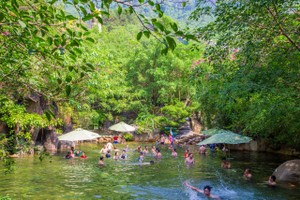 A group of foreign tourists visit Vietnam History Museum in HCMC.
A group of foreign tourists visit Vietnam History Museum in HCMC.
MICE tourism
Taking advantage of a large transshipment area of the country, HCMC has focused on attracting MICE (Meetings, incentives, conferences, and exhibitions) tourists.
Director of the HCMC Department of Tourism Nguyen Thi Anh Hoa informed that the city will receive large groups of around 5,000 tourists coming from different markets. The southern economic hub just saw a cooperation on starting the MICE tourism program in the 2022-2025 period among the Vietnam Immigration Department in HCMC, Southern Airports Authority and HCMC’s Police Department.
Nguyen Quy Phuong, Director of the Tourism Department under the Vietnam National Administration of Tourism (VNAT) said that the VNAT will continue to strengthen an advertising program for the “Live Fully in Vietnam” campaign to welcome back visitors from potential markets in Southeast Asia, the Northeast Asia and Australia; promote Vietnamese tourism on social platforms, the website www.vietnam.travel, and receive delegations of foreign journalists and businesses to the country for tourism surveying.
Travel businesses have been busy bringing international visitors to Vietnam from now until the end of this year.
General Director of Saigontourist Group Nguyen Huu Y Yen said that the company has worked with around 400 partners throughout the world to introduce Vietnamese tourist products in the international tourism season that will run from October, 2022 until March, 2030.
Meanwhile, Viettravel Company will receive regular reservations of delegations of tourists from Singapore, Thailand, India, the Middle East, Europe, and the US. Each group has 25-30 people. The company expects to get about 1,000 inbound visitors by the end of this year.
Improving product quality to strengthen competitiveness
According to the Vietnamese Ambassador to Kuwait, Ngo Toan Thang, Kuwait’s visitors have trends of group travel. High-quality tourist products will spread widely on social networks.
The city’s travel agencies have offered many promotional programs and new tours to draw travelers, such as tour visiting Cu Chi District’s green farms and tunnel operated by Vietravel, offering a discount on entry tickets for visitors who wear Ao Dai (Vietnamese traditional dress) to visit museums, added Nguyen Thi Anh Hoa.
In addition, the city’s tourism sector has frequently organized training courses on IT and digital transformation to the insiders, launched the hotline 1022, and social platforms to provide tourists with assistance and information.
Tourist companies have seen a large number of holidaymakers who book short-distance trips to destinations of Phu Quoc, Con Dao, Nha Trang, Long An, Da Lat during the upcoming holidays on Reunification Day (April 30) and Labor Day (May 1).
The Health Ministry’s Covid-19 prevention and control measures for international travelers
The Ministry of Health has issued prevention and control measures for pandemic for international travelers in the context of safe, flexible adaptation to and effective control of the Covid-19.
Accordingly, air passengers must have proof of negative SARS-CoV-2 tests using the RT-PCR/RT-LAMP method within 72 hours prior to departure, or 24 hours with rapid antigen tests, the results must be approved by the countries where the tests are conducted. Children under two years old are exempt from this testing rule. Entrants needn’t take another Covid-19 test and still comply with pandemic prevention and control measures that are applicable to people living in Vietnam.
People entering Vietnam via other routes and having negative test results for Covid-19 must implement pandemic prevention and control measures that are also similar to entrants by air.
If they haven’t had a negative test result for Covid-19 at the time of entry, they will need to get a test within 24 hours of entry (either RT-PCR/RT-LAMP or rapid antigen tests).
At the border gates, if visitors have symptoms of Covid-19, such as fever, cough, sore throat, runny rose, blocked nose, body aches, fatigue, chills, reduced sense or complete loss of sense of smell and taste, they have to report to the health units at the border gates in accordance with health and safety requirements.
Foreign visitors need to have medical insurance cover for Covid-19 treatment worth at least US $10,000.
























